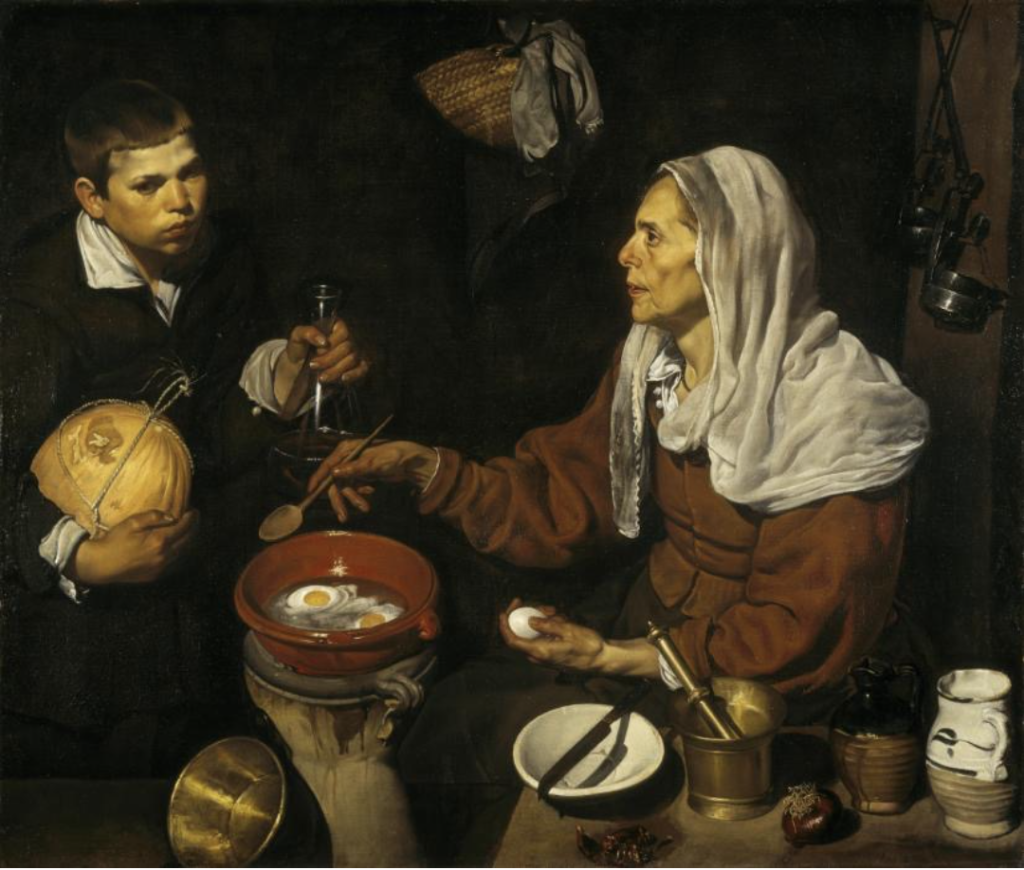
A Masterpiece in Texture and Culinary History
Diego Velázquez (1599-1660) was in his late teens when he painted the masterpiece, “An Old Woman Cooking Eggs,” now on view at the Frick Collection, together with other paintings on loan from the Scottish National Gallery. Art lovers and culinary historians can benefit from multiple viewings of this stunning achievement.
The painting depicts an old woman doing precisely what the title claims while a young boy stands by holding a flask in his left hand and cradling a rope-wrapped melon in the crook of his right arm. It is an example of the bodegón, paintings of humble kitchen and tavern life, at which Velázquez and his contemporaries excelled during the Spanish Golden Age.
The viewer will marvel at the richness and variety of shape, textures, and surfaces brought to life by Velázquez’s confident brush. The figures and household objects seem to emerge from the darkness. The light, from an indeterminate source, draws the observer’s eye diagonally across the canvas from the boy’s rumpled collar in the upper left corner to the partially glazed pitcher in the lower right. Along the way, the light illuminates two eggs poaching in a stoneware vessel and a simple white dish on which a knife rests precariously. Dead-center in the lower third, an egg glows like an orb lit from within.
The culinary historian may wonder how exactly the eggs were prepared in 1619, the approximate year of composition. Spanish culinary expert Janet Mendel, (My Kitchen in Spain) explains that the woman is cooking the eggs in a generous amount of olive oil, in a traditional earthenware casserole or cazuela. “This is still the usual way of frying eggs,” writes Mendel in an e-mail. “She uses the wooden spoon in her hand to ladle hot oil over the tops of the eggs.”
“Done properly,” writes Mendel, “the eggs come out ‘estrellados,’ with a little golden edge on the whites.”
Rarely visible in reproductions but clear in the painting is the sliver of glowing coal in the brazier beneath the cazuela.
What of the other objects in the painting? According to Mendel, the brass mortar and pestle are still used in Andalusia to crush peppercorns, saffron, garlic, dried peppers, almonds. Mendel speculates that perhaps the old woman is going to use hers to crush the dried red peppers in the foreground of the painting, the wrinkled burnished skin of which has been faithfully reproduced by the young painter. (Find more from Mendel about the mortar and pestle, plus a great recipe, here.)
The flask in the boy’s hand likely contains a type of white wine, golden in color, somewhat like Sherry. The melon is wrapped in cord so it can be suspended from ceiling beams, safely away from rot and rodents.
“An Old Woman Cooking Eggs” is on view at the Frick through February 1, 2015. From there it will travel to Los Angeles and Forth Worth.
 Stacey Harwood is managing editor of The Best American Poetry website and blog. Her writing about food and cooking has appeared in The Wall Street Journal, Saveur, Saveur.com, and Time Out New York. She will teach Food Narratives at the New School during the Spring 2015 semester.
Stacey Harwood is managing editor of The Best American Poetry website and blog. Her writing about food and cooking has appeared in The Wall Street Journal, Saveur, Saveur.com, and Time Out New York. She will teach Food Narratives at the New School during the Spring 2015 semester.


2 Comments
This is wonderful Stacey.You always make every art better
Stacey, i really enjoyed this piece. I will look at paintings of everyday tasks differently now.